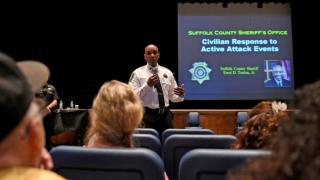Riverhead school district teachers and staff gathered in the high school auditorium Monday to train for what has become an increasing threat to schools nationwide — an active shooter.
The need for drills and training is “an unfortunate reality,” said Riverhead Superintendent Aurelia Henriquez.
The 17 people shot dead Feb. 14 at Marjory Stoneman Douglas High School in Parkland, Florida, and more recently, the May 18 shooting that killed 10 people at a high school in Santa Fe, Texas, are a reminder that it can happen anywhere, Henriquez said. “That’s a scary thought, but again, we’re interested in being prepared.”
After a forum in March after the Parkland shooting, the Suffolk County Sheriff’s Department began offering the “Civilian Response to Active Shooter” training sessions.
Riverhead is one of a handful of school districts that have taken advantage of the program, which has trained more than 1,000 people so far, said Deputy Sheriff Capt. John Rung. The session Monday was one of four the Riverhead district will host to ensure all faculty and staff are trained.
Three more districts plan to offer the training in August, said Rung. He declined to release the names of the other districts as a security precaution.
“There’s no way you could expect to survive one of these attacks if you’re not prepared,” Rung said. “And that preparation comes from training and really taking upon themselves, each teacher, to be prepared.”
The hourlong presentation describes what happens to a person in an emergency situation and how to respond, using lessons learned from past attacks.
Teachers were asked to consider how they set up their classroom. The teacher’s desk, for example, could be located closer to the door, to block it if there’s an active shooter.
Schools also can focus on being more vigilant about students, flagging those who may show signs of violent or unstable behavior, according to the training.
The method, which was developed by Texas State University and can be used in any emergency situation, is to avoid, deny and defend.
If possible, staff should try to get students out, leaving the building or the area where the shooter is, according to the training. If there is no way out, the focus should be on denying access to the room. And if it comes down to it, faculty and staff need to be prepared to defend their classroom.
“The most important thing with this initiative is really just the awareness,” Suffolk Sheriff Errol Toulon Jr. said.
As part of a series of initiatives Toulon launched after taking office Jan. 1, districts also can opt to have his office conduct a security risk assessment, which looks at infrastructure, policies and procedures, as well as workforce empowerment, such as the active shooter training.
Rebecca Krupski, a physical education teacher at Riverhead High School, was visibly moved by some of the examples given in the training, which included a recording of the 911 call from the 1999 Columbine school massacre.
“I think we all learned something,” she said. “It’s scary for us educators and staff, and I feel sad for our students that have to think this way, but it’s trainings like these that make a difference.”

